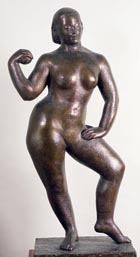Sources
Source Selection
A detailed study was undertaken during the project's development phase to define and select suitable sources from the wealth of documentary and published materials available for the period 1851-1951. As a result of this investigation the following decisions about source selection were taken:
- In order to chart the full range of professional practice, documentary materials that cover the various stages in a sculptor's career – from different types of training through to major exhibitions and public honours – were chosen (see brief description below).
- To capture as wide a view of practice as possible and to make the process of selecting and entering data into the database faster, sources that contained information on many artists or businesses in relatively short form were identified. This led to a decision to omit archives of individual sculptors and related businesses because the content is too detailed and such a small proportion of artists' personal papers or business records survive.
- Images were not considered essential to address the research issues and locating, resourcing and seeking rights to reproduce works of art was found to be impractical within the project's current timescale and budget. The addition of images may be considered for a separately funded extension to Mapping Sculpture 1851-1951.
Main Groups of Sources
These are the main groups of sources that are being used during the research programme. A brief description of their significance and the type of information they contain is also given:
Art Schools
Sources: annual reports, prospectuses, publications, (e.g. student journals, histories).
Description: Art schools are a crucial part of local art infrastructures that became widespread in the latter decades of the 19th century. They brought professionally trained sculptors to the regions and were an important networking hub. Course details offer data on methods and techniques
Exhibition Records
Sources: exhibition catalogues, annual reports, and publicity material.
Description: Exhibition records provide numerous data including personal information (dates active, nature of work, location); information on patterns of exhibiting (who showed, where, what and when); how sculpture was displayed (important variations according to date and venue); and price range or value.
Art Societies
Sources: mission statements, membership records, annual reports, minutes, committee lists, publicity material, published and unpublished histories.
Description: Art Societies were essential venues for networking with artists, patrons and other professions. The status of sculptors is manifested in policies and participation. The number, distribution and purpose of organizations reflect developments in local art infrastructures and the profession. Applications for support give data on failure, level of indigence, career trajectories.
Related businesses
Sources: trade and post office directories, trade catalogues, manuals, advertisements, printed publicity and ephemera.
Description: Trade directories are one of the best surviving records of businesses and are the most effective means of conducting a national survey. They are being sampled for given categories at ten-year intervals. Catalogues, manuals etc. have survived erratically but are also very valuable sources.
Periodicals and journals
Sources: events and exhibition listings, news items, advertisements, obituaries, indexes, press-cutting albums.
Description: Selected art and architectural periodicals, trade journals, numismatic and medal society journals, local newspapers and periodical to be investigated because they are a primary source of data on local activity, collaborations between sculptors and architects, associated businesses and trades

QUICKLINKS

